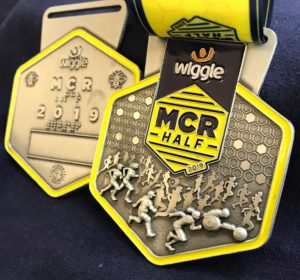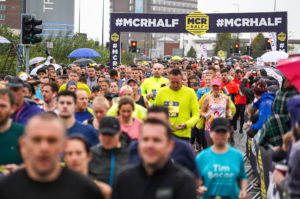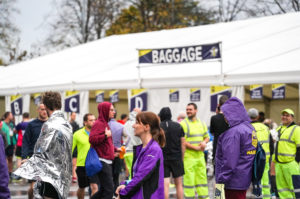5 things you never knew visually impaired (VI) runners have to deal with
Chris Vaughan is a visually impaired runner and a former member of our Inclusivity Panel. We asked Chris to share some of the issues he and his guide face at mass participation events, to help us and fellow participants understand the challenges.

Guide Runners are more than just runners
Firstly, in order for a visually impaired person to take part in an event such as the Wiggle Manchester Half, they need to have a running guide. Several aspects have to line up here, as it is important that not only the VI and guide have similar height and build, but pacing, locality, and availability to train as much or as little as the VI runner needs are vitally important, and of course they have to like each other and get on!
The VI has to put an enormous amount of trust into their guide, and it can take time for these relationships to develop, making it essential to have a guide well in advance of training schedule start dates.
It is also recommended to have a number of guides for different distances and to cover absences due to injury or illness, as an example.

Entering Events
The Wiggle Manchester Half offers all guide runners free entry. We recognise that things are complicated enough, without further challenges trying to enter an event. Often this can be back and forth experience, so we make it super easy for them.
There are a small number of visually impaired participants at mass participation events. If you are visually impaired and would like to take part in the Wiggle Manchester Half please email info@mcrhalf.co.uk to receive a bespoke code for entering your guide.
Bag Drop
Bag drop can be a stressful experience for the visually impaired. It’s likely that they haven’t met up with their guide runner yet and it’s incredibly busy at bag drop, many participants are arriving at the same time all trying to check in their bag so it can be a confusing and worrying time.
As it can be very busy, we always recommend all participants bring only essentials, and wherever possible leaving your bag with friends or family.

The Start
The crowd at the start wave is difficult for both the VI runner and guide as they have to navigate their way through lots of people to get to the appropriate start point. This factor can cause anxiety and undue pressure and stress on the guide and VI runner, before running even starts.
We start VI participants and their guide runners at the start of each wave, thus less pressure and offers a clear running opportunity. Plus there’s an opportunity to chat to other VI participants and guides before setting off. As the VI community is small, many runners know each other and this is a nice way to allay fears and build confidence for the run.
Water/Fuel Stations
A tricky time for the VI runner and their guide, with lots of other runners in front and behind stopping for their fluid top up, It’s super important our crew manning water/fuel stations are aware and can identify VI runners/guides easily and pass water efficiently.
It is usual practice for the water/fuel to be handed to the guide runner to pass to the athlete.
We encourage all runners to be vigilant and mindful, making way to help VI runners at water/fuel stations.
Would you like to help?
If you have any questions about the issues raised in this article please email us at info@mcrhalf.co.uk
If you are interested to learn more about becoming a guide runner you can visit www.englandathletics.org and attend a Sight Loss Awareness and Guide Running workshop.
With special thanks to Chris, we are taking steps to make changes to meet Chris and other visually impaired runners’ needs and will keep you updated on the work we are doing to make our event fully inclusive to everyone.
